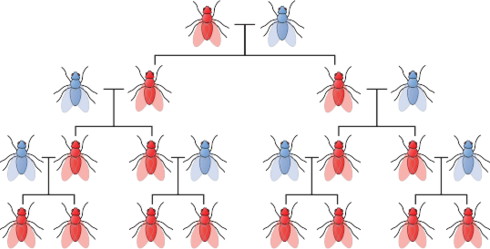Gene drives and societal narratives
By Brigitte Nerlich,
Making Science Public
| 08. 21. 2020
A review of nine previous posts about gene drives, most by the same author
Some days ago, I came across an interesting virtual conference (HT @Sarah_A_Hartley) about gene editing which includes a session on ‘societal narratives’. I have written quite a bit about societal narratives of gene editing, but more recently I became involved in the issue of ‘gene drive’, that is, “a system of biased inheritance in which the ability of a genetic element to pass from a parent to its offspring through sexual reproduction is enhanced”. This is a naturally occurring twist in the laws of inheritance that scientists can use (with the help of gene editing) “to develop [artificial] gene-drive modified organisms for public health, conservation, agriculture, and other societal purposes, for example, by suppressing populations of mosquito species that transmit human diseases such as malaria, dengue, Zika, and chikungunya among others” (Gene drives on the horizon, 2016).
I suddenly asked myself: Are there any societal narratives emerging around gene drives? Cloninghas societal narratives, recombinant DNA has societal narratives, genetic engineering has societal narratives (I can’t wait for @matthewcobb’s book about this), genomics has societal narratives, genetic...
Related Articles
By Aisha Down, The Guardian | 11.10.2025
It has been an excellent year for neurotech, if you ignore the people funding it. In August, a tiny brain implant successfully decoded the inner speech of paralysis patients. In October, an eye implant restored sight to patients who had...
By Jessica Hamzelou, MIT Technology Review | 11.07.2025
This week, we heard that Tom Brady had his dog cloned. The former quarterback revealed that his Junie is actually a clone of Lua, a pit bull mix that died in 2023.
Brady’s announcement follows those of celebrities like Paris...
By Heidi Ledford, Nature | 10.31.2025
Late last year, dozens of researchers spanning thousands of miles banded together in a race to save one baby boy’s life. The result was a world first: a cutting-edge gene-editing therapy fashioned for a single person, and produced in...
By Lauran Neergaard, AP News | 11.03.2025
WASHINGTON (AP) — The first clinical trial is getting underway to see if transplanting pig kidneys into people might really save lives.
United Therapeutics, a producer of gene-edited pig kidneys, announced Monday that the study’s initial transplant was performed successfully...




